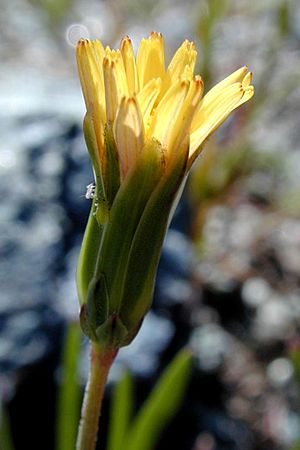Douglas' silverpuffs facts for kids
Quick facts for kids Douglas' silverpuffs |
|
|---|---|
 |
|
| Scientific classification | |
| Genus: |
Microseris
|
| Species: |
douglasii
|
Microseris douglasii, also known as Douglas' silverpuffs, is a type of flowering plant. It belongs to the aster family, which includes many well-known flowers like sunflowers and daisies. This plant is found naturally in western North America. You can see it growing from Oregon and California all the way down to Baja California in Mexico.
Douglas' silverpuffs likes to grow in different places. These include open grasslands and special wet areas called vernal pools. It can also be found in soils that contain clay or a unique type of rock-based soil called serpentine.
What is Douglas' Silverpuffs?
Douglas' silverpuffs is an annual plant, which means it completes its whole life cycle in one year. It grows from a group of leaves at its base, called a rosette. This plant can be quite small, about 5 centimeters tall, or grow to be over half a meter tall. It usually doesn't have a main stem above the ground.
What Does It Look Like?
Each leaf of the plant can be up to 25 centimeters long. The edges of the leaves can be smooth, have small teeth, or be divided into many smaller parts.
The plant's flower structure grows on a stalk called a peduncle. This stalk can stand straight up or curve. Each flower head is actually made up of many tiny flowers. It can have up to 200 white or yellow ray florets, which are like the petals you see on a daisy.
The Seeds and How They Spread
After the flowers bloom, they produce a fruit called an achene. This achene is like a small seed. It can be brown or almost black, and sometimes it has speckles. The achene can be up to a centimeter long. At the top of the achene is a large pappus. This pappus is made of about five long, bristly scales that have tiny barbs. These scales help the seeds float in the wind, allowing them to spread to new places.

